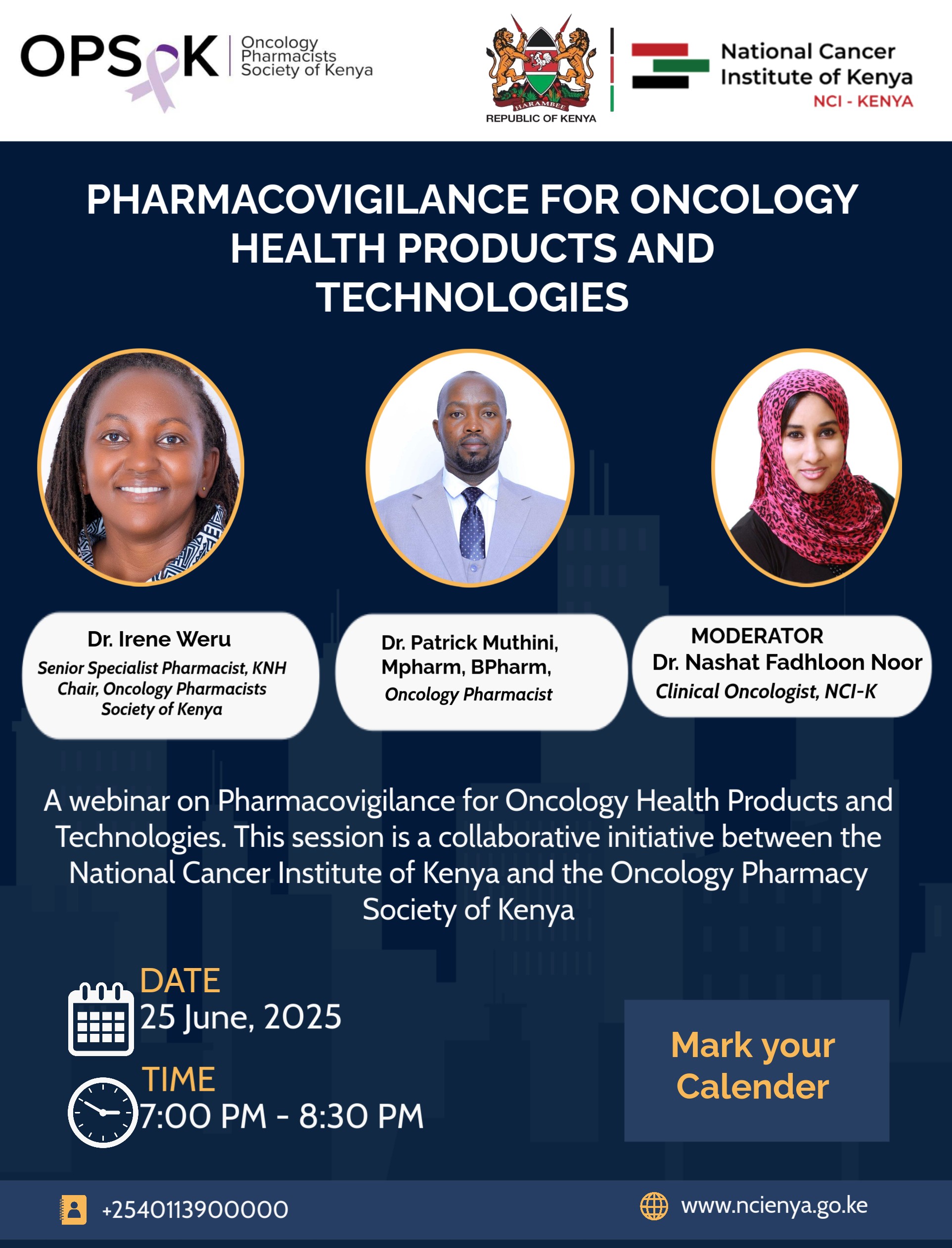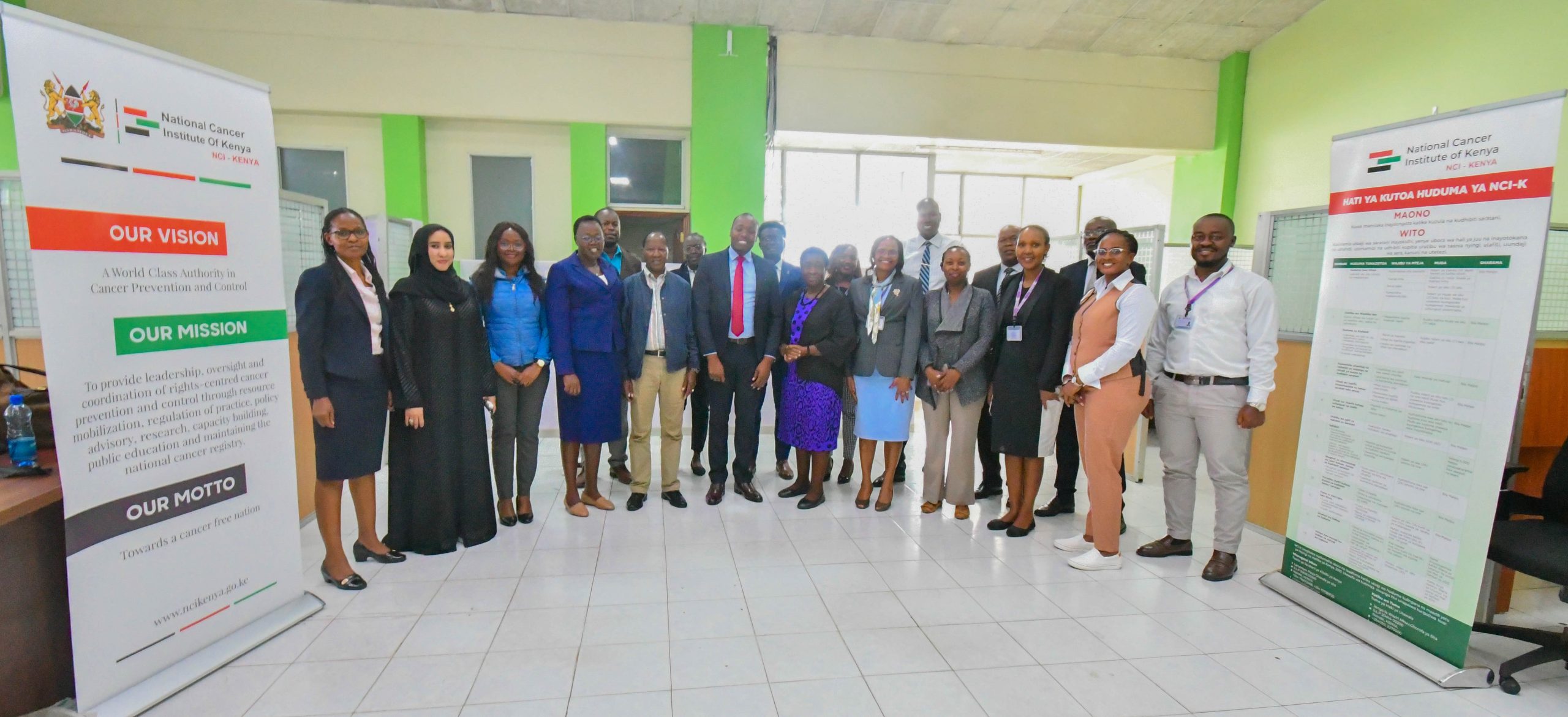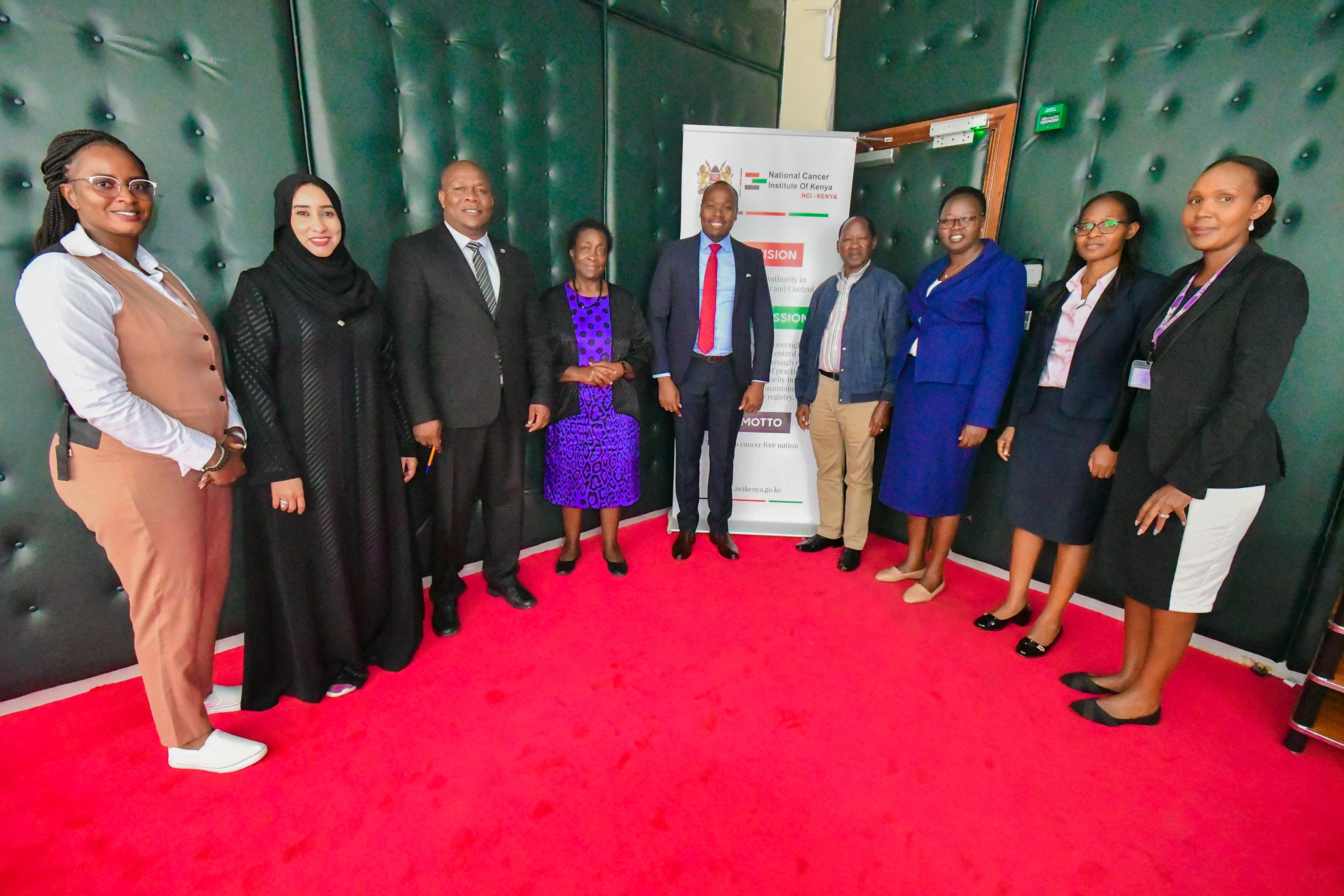🔔 Webinar Alert! 🔔
Join the National Cancer Institute of Kenya (NCI-K) and the Oncology Pharmacy Society of Kenya for a webinar on Pharmacovigilance for Oncology Health Products and Technologies.
🗓 Date: Wednesday, 25th June 2025
⏰ Time: 7:00 p.m. – 8:30 p.m. (EAT)
Featuring Expert Speakers:
· Dr. Irene Weru (KNH & Chair, Oncology Pharmacists Society of Kenya)
· Dr. Patrick Muthini (Head of Oncology Pharmacy Services, Phangisile Mtshali Cancer Center)
· Moderated by Dr. Nashat Fadhloon Noor (Clinical Oncologist & Head of Cancer Prevention and Control, NCI-K)
Don’t miss this important discussion on patient safety in cancer care.
meet.google.com/cby-rhvq-xxb
Category: Uncategorized
-

Pharmacovigilance for Oncology Health Products and Technologies Webinar
-
World Cervical Cancer Elimination Day
World Cervical Cancer Elimination Day Set
The World Health Assembly has taken a monumental step in the global fight against cancer by officially designating November 17th as World Cervical Cancer Elimination Day. This landmark decision, set to be observed annually starting in November 2025, highlights a collective commitment to eradicate a preventable and treatable disease. It builds upon a foundational resolution from 2020 that adopted a comprehensive global strategy to accelerate the elimination of cervical cancer as a public health problem.

This designation comes in recognition of the disproportionate burden cervical cancer places on women globally, particularly in developing countries and among those living with HIV. Despite being largely preventable and highly curable if detected early, it remains one of the most common causes of cancer-related morbidity and death in women. A significant challenge highlighted is the far-from-goal vaccination coverage against Human Papillomavirus (HPV), the leading cause of this cancer.
The strategy for elimination centers on highly cost-effective primary and secondary prevention approaches. This includes robust HPV vaccination programs and widespread access to screening for and treatment of precancerous lesions. The resolution emphasizes that boosting public awareness, ensuring access to vital information, and providing comprehensive services are paramount elements for effective prevention and control across the entire life course.
In support of this global initiative, Member States are strongly urged to allocate sufficient resources to expand healthcare services for cervical cancer elimination efforts, aligning these with national priorities and universal health coverage goals. The Director-General of the World Health Organization (WHO) has been requested to actively utilize World Cervical Cancer Elimination Day to strengthen stakeholder engagement, drive innovation, mobilize resources, and highlight progress made by Member States in their pursuit of elimination targets.
Furthermore, the resolution calls upon all international organizations, stakeholders, and partners to enhance multilateral collaboration. Their support is vital in promoting knowledge, ensuring access to safe, affordable, and quality services, and developing effective healthcare products. This concerted global effort aims to foster solidarity across countries, pushing forward the world’s first-ever endeavor to eliminate a cancer as a public health problem.
-

NCI-K Pursues Research Institution Accreditation
NACOSTI Visits NCI-K
Today, the National Cancer Institute of Kenya hosted a delegation from the National Commission for Science, Technology and Innovation (NACOSTI), a state corporation mandated to regulate and assure quality in science, technology, and innovation.

The primary purpose of the visit was to assess NCI-K’s capacity to be registered as a research institution. This is one of NCI-K’s commitments to not only provide top-tier cancer care but also contribute to the advancement of cancer research in Kenya.
Dr. Elias Melly, CEO of NCI-K, warmly welcomed the NACOSTI team, emphasizing the importance of this assessment for the institute’s future endeavors.
The NACOSTI team was led by Prof. Vassey Mwaja, Ph.D., Vice Chairperson of the African Scientific Research and Innovation, and Prof. Mabel Imbuga, former Vice Chancellor of Jomo Kenyatta University of Agriculture and Technology (JKUAT), Situma Stephen, Christine Anakoeng, among other distinguished members.

This visit is an important step in NCI-K’s journey to becoming a recognized research institution, a journey towards full implementation of the Cancer Prevention and Control Act, 2012, paving the way for greater contributions to cancer research and improved patient outcomes.
-

Meeting with H.E. Governor Dr. Wilber Ottichilo on Cancer Control Collaboration
Mr. Chrisantus Wekesa, the National Cancer Institute of Kenya Capacity Building Officer, today, the 7th of May 2025, held a consultative meeting with H.E. Dr. Wilber Ottichilo, Governor of Vihiga County, to deliberate on strengthening cancer prevention and control efforts through devolution. Their discussions focused on establishing a collaborative framework between the National Cancer Institute of Kenya (NCI-K) and the County Government of Vihiga, in line with the National Cancer Control Strategy (2023–2027).

H.E. the Governor expressed his commitment to supporting cancer control initiatives and pledged to champion the development of a structured partnership between NCI-K and Vihiga County. This collaboration will aim to enhance cancer awareness, early detection, timely referral, and access to quality cancer care services at the level.
Later, Mr. Wekesa met with the County Health Management Team, led by Dr. Induswe Benjamin, in a discussion that focused on the five pillars of the National Cancer Control Strategy 2023-2027. The engagement further delved into the various achievements at both the County and National levels, and subsequently the existing gaps in cancer care and the necessary steps in addressing the issues as we gear towards a cancer-free nation.
-
Significant Boost to Oncology Funding Under SHA
There’s a significant advancement in Kenya’s healthcare system, particularly for individuals facing the challenges of cancer. The government, through the Social Health Authority (SHA), has made a crucial enhancement to the annual oncology (cancer management) package, now set at Ksh 550,000 per patient.

This increased support, effective from April 1st, 2025, is structured to provide comprehensive financial assistance. Specifically, Ksh 400,000 will be accessible through the Social Health Insurance Fund (SHIF) program, with an additional Ksh 150,000 available through the Emergency, Critical and Chronic Illness Fund (ECCIF). This expansion is designed to ensure that members receive the necessary care and support during a difficult time.
Furthermore, critical care services, including ICU and HDU, have also seen substantial improvement, with daily coverage increasing from Ksh 4,000 to Ksh 28,000. This adjustment highlights the government’s dedication to making essential healthcare services both accessible and adequately funded. In light of these advancements, the National Cancer Institute of Kenya strongly encourages all Kenyan citizens to register for the SHA, thereby securing their access to these vital medical care provisions.
-
Enhancing Esophageal Cancer Care in Kenya: Policy Recommendations
Esophageal Cancer Awareness Month helps spread information about esophageal cancer. This type of cancer affects the esophagus, the tube that food travels through from the mouth to the stomach.
Esophageal cancer happens when tumors grow anywhere along the esophagus, the muscular tube that leads from the mouth to the stomach.
If this type of cancer is detected early, treatment may be effective and the outlook is better. But most people do not receive a diagnosis until esophageal cancer is in the later stages.
Symptoms of Esophageal Cancer
If you or someone you know is exhibiting symptoms of esophageal cancer, seek medical attention immediately.
Symptoms include:
- Difficulty in swallowing
- Unintentional weight loss
- Chest pain
- Heart burn
- Indigestion
- Coughing
- Hoarse voice
This is to bring to the attention of all stakeholders and general members of the public that the Cabinet Secretary for the Ministry of Health, pursuant to section 36 of the Cancer Prevention and Control Act, No. 15 of 2012 has developed:
1. The Cancer Prevention and Control (Standards of Care) Rules, 2023
2. The Cancer Prevention and Control (Public Awareness and Education) Rules, 2023
3. The Cancer Prevention and Control (Cancer Registries) Rules, 2023
4. The Cancer Prevention and Control (Consent to Research) Rules, 2023
5. The Cancer Prevention and Control (Inspection and Certification) Rules, 2023
Under the Statutory Instruments Act, 2013, the National Cancer Institute of Kenya plans to engage members of the public and stakeholders on the same through public hearings. The purpose of the hearings shall be to get oral submissions on the draft Regulations to ensure that persons likely to be affected by the Statutory Instruments have adequate opportunity to give their views on the Instruments. The Draft Regulations can be obtained from the Institute’s website (The National Cancer Institute of Kenya – NCI Kenya)
-
Breast Cancer Awareness in LMICs: Raising Awareness & Improving Access to Care
This month provides an opportunity for us all to focus on breast cancer and its impact on those affected by the disease in our community.
The total breast cancer cases notified by county of usual residence between the years 2020 and 2023 amounted to 4,824 people in Kenya, Nairobi County leading with the highest number of diagnosed people at 550 followed by Nakuru County which registered 398 people.
Finding breast cancer early provides the best chance of surviving the disease. While mammograms can help to detect cancer before you can feel a lump, breast self-exams help to be familiar with how your breasts look and feel so you can alert your doctor if there are any changes.
Take the time to ‘get to know’ how your breasts normally look and feel through normal regular activities such as showering, getting dressed, using body lotion or looking in the mirror.
You don’t need to use a special technique, but ensure you look at and feel your breasts regularly. Make sure this includes all parts of your breast, your armpit and up to your collarbone.
For women of all ages, it is recommended that you be breast aware.
Changes to look for include:
- a new lump or lumpiness, especially if it’s only in one breast
- a change in the size or shape of your breast
- a change to the nipple, such as crusting, ulcer, redness or inversion
- a nipple discharge that occurs without squeezing
- a change in the skin of your breast such as redness or dimpling
- An unusual pain that doesn’t go away.
Visit a doctor in case you notice any changes in your breast.
Breast cancer signs
According to doctors, it is quite difficult for breast cancer to get diagnosed for women under 40 because their breasts are denser. This means that a tumour, if present, is not likely to show up in a mammogram.
The most common way to detect breast cancer in younger women is to keep a close check on the changes in your breasts. In fact, according to Healthline, a majority of young women diagnosed with breast cancer discover an abnormality themselves. If you notice any changes in your breast, like changes in the skin, nipple discharge, pain, tenderness, or a lump or mass in the breast or underarm area, please report it immediately to a doctor.
Breast cancer is one of the most common cancers in women and there is a misconception among people that it only happens to older women. While it’s true that most breast cancers are found in women who are 40 years or older, it is imperative to know that it can strike any female at any age.
Pain in any Area of The Breast
Check for pain and tenderness in any area of your breast. While lumps don’t usually hurt, some may cause a prickly sensation. However, pain in your breasts can also be due to numerous other benign reasons and hormonal changes.
Unusual Nipple Discharge
An unusual nipple discharge that’s clear, red, brown, or yellow (other than breast milk) can be an early sign of breast cancer. If you notice this, consult a doctor for an evaluation.
Breast Changes
Look for changes in shape, swelling, and difference in size, texture, or temperature of either one or both breasts.
Unexplained Redness/Rash
Early warning signs of breast cancer can include unexplained redness, swelling, itchiness, or rash on one or both breasts.
Swelling around the Collarbone or Armpit
Consult your doctor if you notice swelling around your collarbone or under the arm. It could be a sign that the breast cancer has spread to the lymph nodes in that area.
While these are some of the early signs of breast cancer, it is important to remember that these can also be caused by benign conditions. It’s always best to consult a doctor so that they can evaluate and help you determine whether it is cause for concern.
Apart from this, it’s also important to keep in mind that often, women with breast cancer have no symptoms. This is why regular breast screening is important to detect it. The main tool to diagnose breast cancer is a mammogram, which basically shows normal and abnormal breast tissue.
It is recommended that women should start getting mammograms when they cross the age of 40 and should continue getting one every 1 or 2 years. Meanwhile, for women above the age of 20, monthly breast self-examination is recommended.
-
Cervical Cancer Screening: Importance of Pap smear.
A Pap test, sometimes referred to as a Pap smear, is a treatment used to detect cervical cancer in female patients.
Cells from your cervix, which is the lower, thin end of your uterus that is at the top of your vagina, are collected for a Pap smear.
You have a better chance of being cured if you have a Pap smear early enough to detect cervical cancer. A Pap smear can also find alterations in your cervical cells that point to the potential for cancer to arise in the future. Your first step in preventing the potential onset of cervical cancer is to have a Pap smear early to identify these abnormal cells.
The Pap smear is usually done in conjunction with a pelvic exam. In women older than age 30, the Pap test may be combined with a test for human papillomavirus (HPV) — a common sexually transmitted infection that can cause cervical cancer. In some cases, the HPV test may be done instead of a Pap smear.
Pap smears are crucial for women’s healthcare and offer a number of advantages, including:
- Pap smears may detect cervical cell changes in your body that could turn into cancer if left untreated
- Pap smears can help find cervical cancer in its early stages, making it easier to treat
- Pap smears allow for early detection which could mean less treatment and less recovery
- Pap smears catch HPV that has been dormant. The HPV virus can be dormant for years and then suddenly become active so it is still important for all women to get Paps, regardless of age or sexual activity
- Pap smears are extremely accurate and regular screenings can reduce cervical cancer rates and mortality by at least 80%
